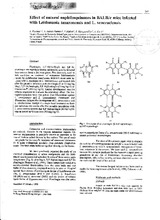Mostrar el registro sencillo del ítem
Effect of natural naphthoquinones in BALB/c mice infected with Leishmania amazonensis and L. venezuelensis
| dc.contributor.author | Fournet, A | |
| dc.contributor.author | Barrios, A Angelo | |
| dc.contributor.author | Muñoz, V | |
| dc.contributor.author | Hocquemiller, R | |
| dc.contributor.author | Cavé, A | |
| dc.date.accessioned | 2017-09-15T15:15:46Z | |
| dc.date.available | 2017-09-15T15:15:46Z | |
| dc.date.issued | 1992 | |
| dc.identifier.uri | http://repositorio.umsa.bo/xmlui/handle/123456789/12471 | |
| dc.description.abstract | Abstract. Plumbagin, 3,3’-biplumbagin and 8,8'-biplumbagin are naphthoquinones isolated by activity-directed fractionation from a Bolivian plant; Pera benensis, used in folk medicine as treatment of cutaneous leishmaniasis caused by Leishmania braziliensis. BALB/c mice were infected with L. mexicana or L. venezuelensis and treated 24h after the parasitic infection with plumbagin (5 or 2.5mg/kg /day), 3,3'-biplumbagin, 8,8'-biplumbagin (25 mg/kg/d) or Glucantime (200 mg/kg /d). Lesion development was the criteria employed to evaluate the inhibitory effect. The bisnaphthoquinones were less potent than Glucantime against L. amazonensis and L. venezuelensis. Plumbagin and Glucantime delayed the development of L. amazonensis and L. venezuelensis. Assays of a single local treatment on footpad infection two weeks after the parasitic inoculation with L. amazonensis showed that 8,8'-biplumbagin (50mg/kg/d)was as potent as Glucantime (400 mg/kg/d). | es_ES |
| dc.language.iso | en | es_ES |
| dc.publisher | Trop. Med. Parasitol | es_ES |
| dc.subject | LEISHMANIA AMAZONENSIS | es_ES |
| dc.subject | LEISHMANIA VENEZUELENSIS | es_ES |
| dc.subject | NAFTOQUINONAS | es_ES |
| dc.title | Effect of natural naphthoquinones in BALB/c mice infected with Leishmania amazonensis and L. venezuelensis | es_ES |
| dc.type | Article | es_ES |

